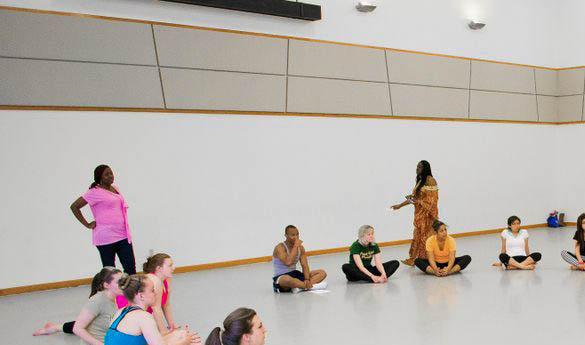Dance class provides a taste of African culture
Students circle up and get their marching orders. Once they receive their schedule the instruction begins and students are forced to step out of their comfort zone and dance their “buttsy” off.
“You hear about this class before you ever walk in,” said junior Elle Thomas, a current student of Nuamah’s. “The class exceeds [your] expectations.”
Kukuwa Nuamah teaches the African dance class that serves as a general education arts credit. While many students take the class to fulfill the art requirement, they’re left with something much more than the knowledge of a new dance.
“This is my family. Welcome,” said Nuamah.
As the class settled in, the usual pre-class chatter was going on. Nuamah, demanding attention, spoke to her class: “Hello! We have guests, and we are acting like this? We need to be on our best behavior.”
Sitting in a circle, Nuamah normally welcomes her class the way a loving mother would, gathering up her children and greeting them with a hug and a smile. Yet, like every mother there is a strictness mirrored in her kindness. Nuamah encourages her students, but, at the same time, does not take any nonsense.
“I know the balance of how to reach my students,” Nuamah said in an interview.
 |
| Students in Nuamah's African Dance 118 class learn up to eight African dances throughout the semester (photo by Gopi Raghu). |
Nuamah uses humor to engage with her students, earning their respect, and resulting in a relaxed environment for students.
Structuring her class as one part dance instruction and one part cultural education, Nuamah gives each student an African name. Nuamah uses these names as a way of making her students feel like they are actually in a country in Africa, making the classroom experience more authentic.
Along with an African name, students learn the contexts behind the dances that Nuamah demonstrates. Students also learn about the 52 countries that make up the continent of Africa and watch documentaries for assignments at the beginning of the semester.
“I don’t want students to walk out without knowing the culture I’ve taught and educated them on,” said Nuamah.
On the day I visited, students were learning the ritual dance Fuba, a traditional dance encouraging the rain to water crops. Before learning a new dance, students learn the history of each dance, making the body gestures personal for each student. As Nuama instructs her class in each movement, former students are often found attending, helping Nuama instruct the class.
By the steady beat of a drum, Nuamah first demonstrates the moves for her students and soon has them follow her actions. After the initial instructions, Nuamah runs through the motions over and over again until students understand the movements. Despite the physical intensity of the dance, students bear smiles.
 |
| Students in Nuamh's African Dance class practice the routine after Nuamah teaches them the dance they'll be learning all week (photo by Gopi Raghu). |
One reason for the smiles could be some of her trademark comments to the class.
“Excuse me, I need you all to pay attention to my bootsy,” Nuamah instructs her students as she points to her “bootsy.” “I need you to move your bootsy. I know you all have one so don’t disappoint me.”
Nuamah’s caring nature comes out as she focuses on specific students who might be struggling with certain movements.
“She has patience when she teaches people,” says student Areil Robinson. “If you’re struggling with a move, she doesn’t mind staying back to help better you as a student...she’s like a mother, but a dancer who pushes you to your greatest potential."
*Connect2Mason's Executive Editor, Reuben Jones, contributed to this piece.*

